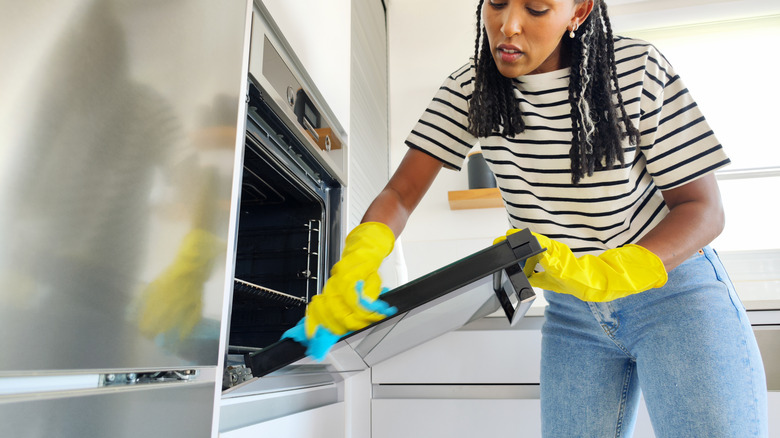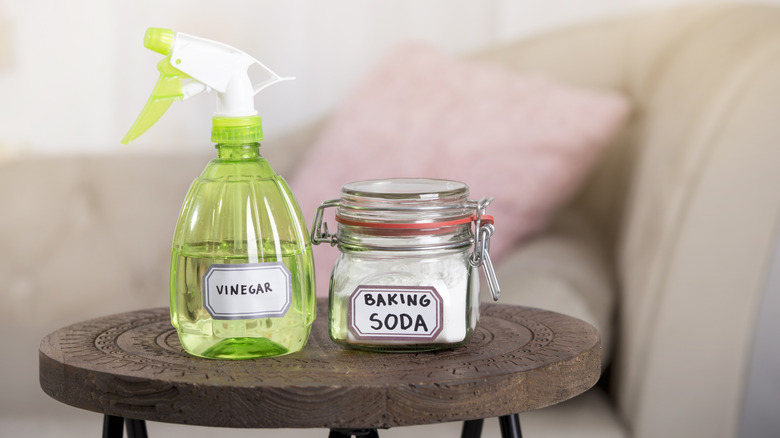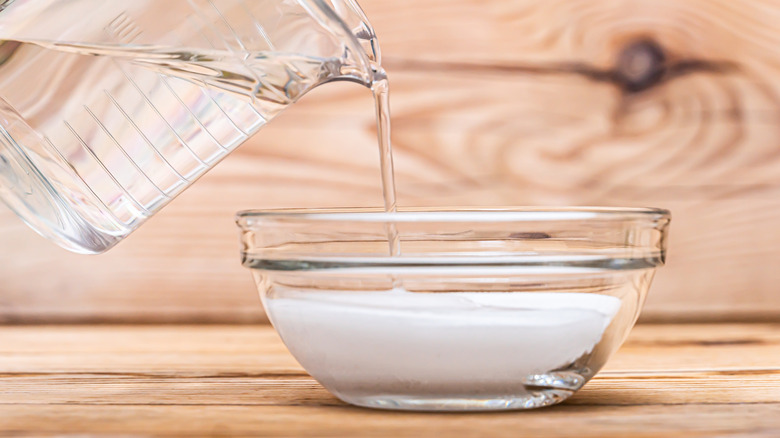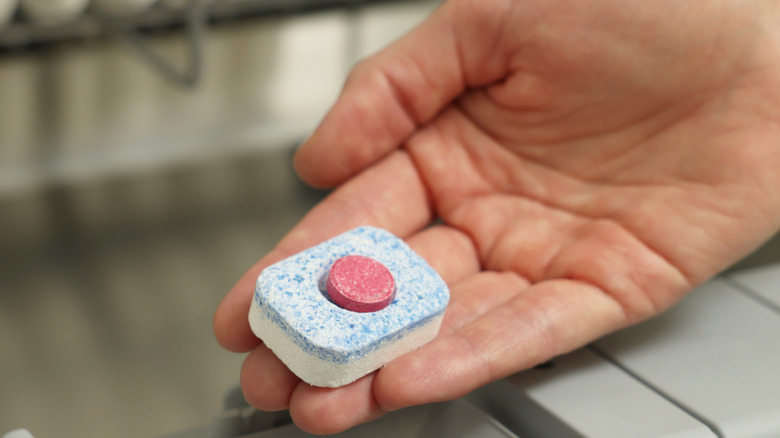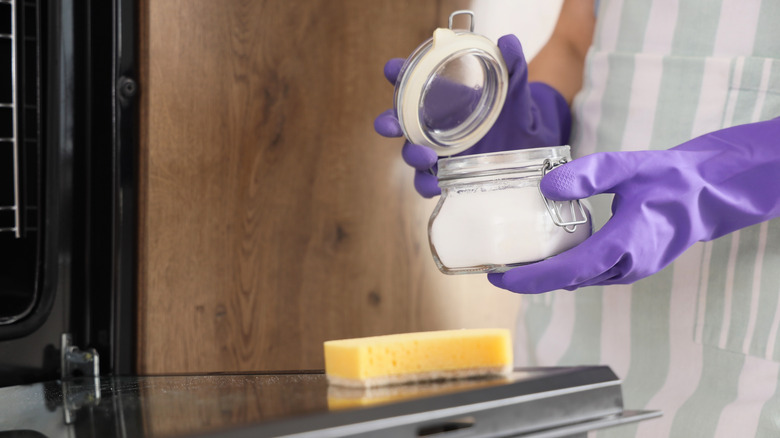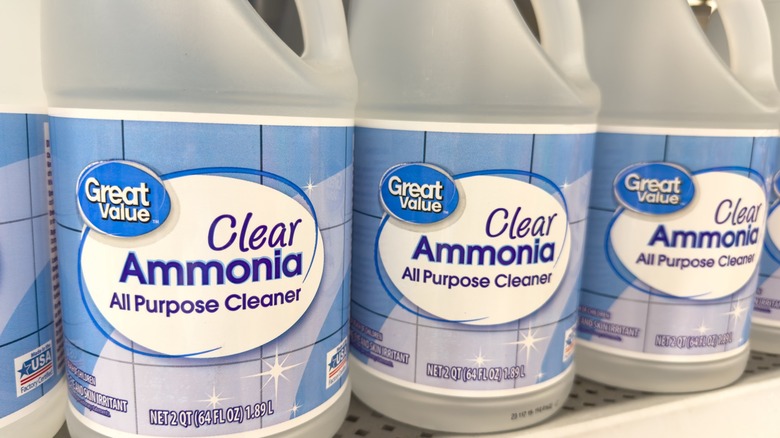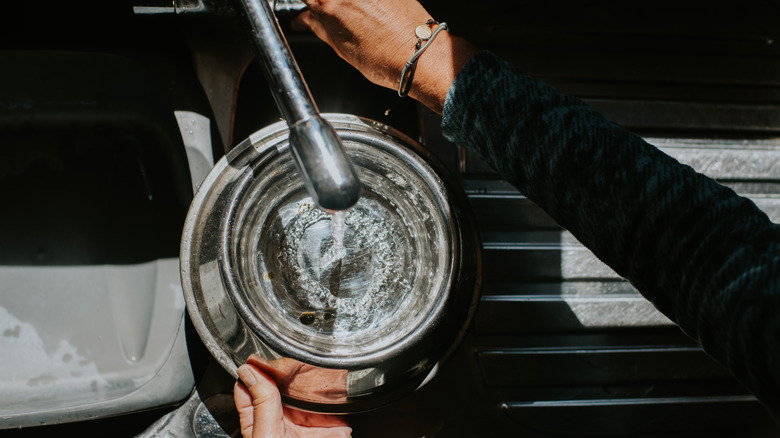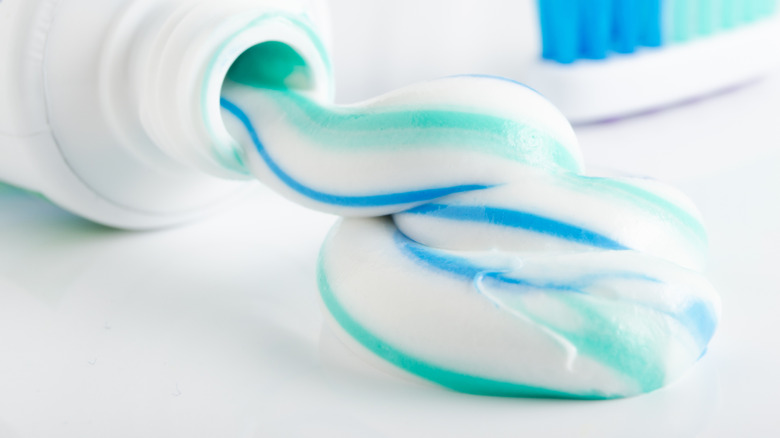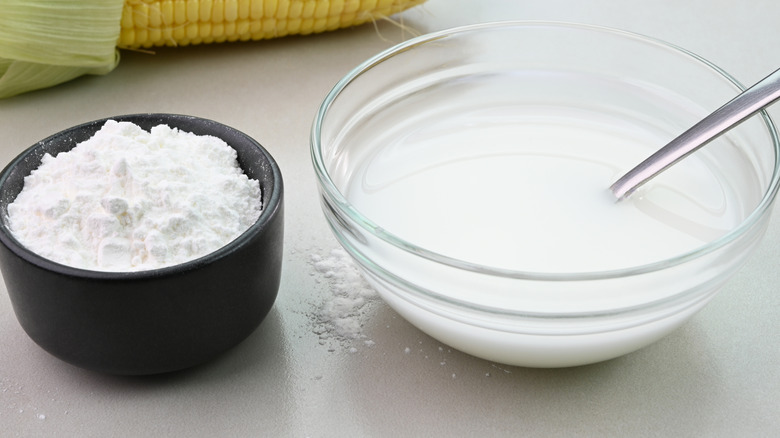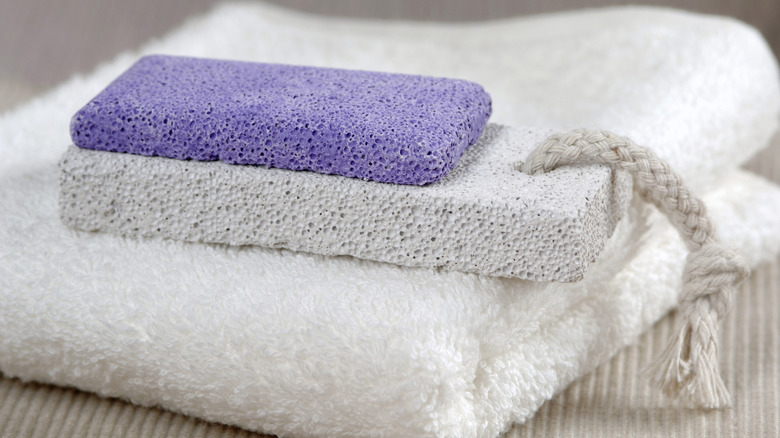Popular Oven Cleaning Hacks You Should Avoid At All Costs (& 5 To Try Instead)
We may receive a commission on purchases made from links.
Replicating the easy-bake lasagna or cookies recipe you find late at night while scrolling social media might seem like a good idea. And it can be rewarding if the dishes exceed your expectations. But what about the spilled cheese, burnt chocolate chips, and grease littering the appliance? You can't leave them be since a dirty appliance is a recipe for disaster. It'll lead to flavor transfer, unsettling smoke, and unsavory odor. Worse, if the vent gets blocked, the appliance will begin overheating. So, to stop your oven from overheating and prolong its lifespan, it's important to deep clean it every quarter (or semi-annually if you don't cook often). Now, for the hard part: What should you use — and not use — to clean it?
Commercial oven cleaners are a no-go since they contain toxic, corrosive elements like potassium and sodium hydroxide. The good news is you'll find multiple cleaning hacks online to maintain a squeaky clean oven. The not-so-good news? Not all of them are worth the effort. To distinguish the hacks from fads, House Digest spoke to three experts exclusively and asked them to list the ones worth a "try" and ones to "avoid." But before we get to their responses, remember to always shut off the power button and give your oven ample time to cool down prior to cleaning it. In case of a gas oven, shut off the supply valve and pilot light. Moreover, remove the racks and wipe off the loose crumbs to simplify the cleaning process.
Avoid: Baking soda and vinegar paste leads to a tough-to-remove residue
You'll find several recipes online for using baking soda and vinegar to clean your oven. The easiest method involves generously coating the interiors with baking soda, spritzing white vinegar on it, then wiping it off with a towel for a clean oven. Another method involves lining your oven's insides with baking soda and water paste and letting it loosen the grime overnight. Come morning, spray white vinegar generously on the paste and use a cloth dipped in warm water to wipe your oven clean.
However, the baking soda and vinegar combination is a classic example of not believing everything you see on social platforms. Peter Hansen, co-owner and managing member for Sparrow Estate Management, tells House Digest in his exclusive interview, "The reaction between baking soda and vinegar is highly touted on social media, but it's actually counterproductive. When mixed, these ingredients mostly neutralize each other (baking soda is a base, vinegar is an acid), producing water and carbon dioxide, which minimizes their individual cleaning powers."
Plus, you'd need a lot of elbow grease to clean the baking soda and vinegar mixture. Hansen continues, "The bubbly paste can be hard to clean out of the nooks and crannies in the oven, sometimes leaving behind a residue that's tough to remove." So, avoid combining baking soda and vinegar together when cleaning your oven.
Try: Baking soda is a mild alkali that'll leave your oven spotless
Using baking soda is one of the best ways to clean your oven if you don't want to use chemicals. Besides, it'll absorb nasty odors. Hansen agrees and says, "When used on its own, baking soda is an excellent, gentle abrasive." To get rid of the stuck-on grime and burnt crumbs, Hansen suggests, "Make a thick paste of baking soda and water and apply it to greasy spots." Combine ½ cup of sodium bicarbonate with 2 to 3 tablespoons of water. Adjust the water to baking soda ratio until you get a spreadable paste. Use your fingers, a spatula, or a thick paintbrush to coat it generously along your oven's interiors, whipping up more paste as you need it. A toothbrush works best for the nooks and crannies. But don't cover the heating element of your electric oven. Similarly, keep the gas inlet of your gas oven free of the paste.
Hansen continues, "Let it sit for several hours or overnight, which allows the soda's mildly alkaline properties to help lift and soften baked-on grease. This method avoids the neutralizing effect that occurs when baking soda is mixed with vinegar and can be rinsed away with a damp cloth without leaving a harsh residue." Although you might need a damp plastic scraper to remove the particularly stubborn grime. Once you've removed the paste, wipe the cavity with a damp microfiber cloth for a spotless oven. You can also bring your rusted oven back to life with an easy baking soda trick.
Avoid: Dishwasher detergent tablets are abrasive and leave behind chemical traces
Another viral oven cleaning hack is using dishwasher detergents tablets. There are two popular ways to go about it. The first one includes dipping a pressed powder tablet (gel pods are a no-go) in warm water to soften it, then rubbing it against the oven door and interior to lift baked-on stains and caked grime. Alternatively, some drop a dishwasher detergent tablet in a bowl of water and bake it in the oven, dipping a sponge in the "baked" solution, and using it to scrub the interiors clean.
While the first method relies on a dishwasher detergent tablet's abrasiveness, the second depends on its cleaning abilities. But both are a recipe for disaster. Hansen continues, "Rubbing a dishwasher tablet on oven grime is another popular method, but it's surprisingly harsh. Dishwasher detergents are meant for heavy-duty cleaning but can be overly harsh for oven surfaces, potentially damaging the enamel and leaving behind residue. Any leftover chemical traces can release fumes when the oven is next used, affecting both air quality and possibly the taste of food." So, avoid dishwasher detergent tablets to maintain bot your oven and household's health.
Try: Clean your oven with a salt and baking soda scrub
Although baking soda is an excellent cleaning agent, it might not leave your oven spick-and-span if there's a lot of charred mess clinging to the appliance's walls, sides, and bottom. This is where table salt comes in. Hansen mentions, "A mixture of coarse salt and baking soda creates a scrub that's gentle yet effective at scouring away stubborn grime without damaging the oven's interior." Combine 1 pound of sodium bicarbonate with 1 tablespoon of salt and 2 tablespoons of water. You might have to add more water if the paste is too thick.
Once the consistency resembles that of a toothpaste, Hansen says, "Apply this paste to grime, and scrub gently with a soft cloth or non-abrasive sponge for great results." Alternatively, leave the paste overnight to loosen the stuck-on food crumbs and lift the stubborn stains. Get a rubber spatula or damp paper towels to clean the dirty mess. You can also apply the paste to your oven's glass door if it's looking nasty and follow a similar process to clean it. This works because, "Salt acts as an abrasive, while baking soda lifts oils and grease," explains Hansen.
Avoid: Ammonia is hazardous to work with and gives off toxic fumes
Although mostly used as a fertilizer, ammonia has become a popular household cleaning supply due to its general availability and inexpensiveness. Unsurprisingly, it's being considered a handy product for a spotlessly clean oven. It's commonly recommended online to place a bowl of ammonia on the top rack and a bowl of boiling water on the bottom rack of a still-warm (but turned off!) oven, and then let it sit with the door closed overnight.
However, this "simple" hack has far-reaching consequences. For starters, you want to minimize ammonia's direct contact with your skin or eyes. Inhaling its toxic fumes can irritate your respiratory tract and nose at best, and burn your mouth, stomach, and throat at worst. Hansen seconds this and mentions, "Many sources advise placing a bowl of ammonia in a warm oven to loosen grime, but this is quite risky. Ammonia fumes are toxic, and improper ventilation can make it hazardous to breathe in the air during and after cleaning. Additionally, residual fumes can affect food flavor and quality, and if there's any residue left, it can be a health hazard." Besides, it's not a safe option for a gas oven. Plus, you'll have to be careful with its disposal since it combines with water to give off the corrosive ammonium hydroxide. So, don't take chances with your health and give ammonia a pass when cleaning your oven.
Try: Steam clean your oven with distilled water
In case your oven is just slightly dirty and doesn't require a deep clean, a little bit of steam is all you need for a sparkling oven. Hansen adds, "Steam can be very effective for loosening grease without adding any chemicals." All you have to do is fill the bowl (or dish) with 2 cups of water and place it in the lowest rack. While you can use tap water, use distilled or filtered alternatives to avoid dealing with unsightly spots or mineral deposits. "Place an oven-safe bowl of water in a heated oven — around 250 degrees Fahrenheit or 120 degrees Celsius — for 20-30 minutes," he suggests.
After the time is up, let the oven cool down before removing the water-filled dish and wiping the insides. Once cool, use a damp microfiber cloth (or soft sponge) to scrub the interiors clean. Keep rinsing the cloth in fresh water as it accumulates dirt to avoid spreading it further. Pour a little baking soda on the cloth to loosen caked-on grime. This hack is effective because, "The steam generated softens grime, making it easier to wipe away afterward. Since water is neutral, there's no risk of any harsh reactions, and it's easy to ventilate the oven afterward," mentions Hansen.
Avoid: Toothpaste lacks the degreasing strength of commercial oven cleaners
With the multiple unexpected ways you could be using toothpaste around your backyard and garden, it can be tempting to use this miracle paste to clean your oven, too. The easy process sweetens the pot further. You would just have to apply the paste (directly from the tube!) onto the stains and spills and buff them with a clean cloth.
Despite the ease, the toothpaste hack isn't a great option to clean your oven. In an House Digest exclusive interview, Eliana Coca, owner of E.C. House Cleaning, explains the reason behind this. "One common misconception is the use of toothpaste to clean oven stains. While it's often touted for its abrasive properties, toothpaste is designed for teeth and doesn't provide the necessary strength to tackle heavy-duty grease and grime found in ovens. Commercial oven cleaners, designed specifically for these tasks, contain degreasers and surfactants for effective deep cleaning." So, you'll want to avoid this simple hack when cleaning your oven.
Try: Combine water, cornstarch, and white vinegar for a eco-friendly oven cleaner
Hosting guests is a busy business. It doesn't matter if they'll look for stains in your oven — you want to be prepared just-in-case. But if you have run out of baking soda and don't have enough time to get a new box, Coca has a great hack for you. She says, "A hack I've found genuinely effective is using a blend of water, cornstarch, and white vinegar for oven cleaning." Feel free to guesstimate the recipe, as long as the mixture isn't excessively dry or runny. In case you like working with exact measurements, combine ¼ cup of white vinegar and 1 tablespoon cornstarch with a quart (or two) of warm water. Use a soft sponge to apply it onto the stains or pour it in a spray bottle to keep your hands clean.
Scrub and wipe the dirty oven with a clean microfiber cloth. This hack works because, "The mixture creates a paste that adheres to oven surfaces, allowing the cornstarch to absorb oils and the vinegar to break down grease," explains Coca. But that's not the only reason you should consider this hack. Highlighting its eco-conscious properties, Coca elaborates, "It's an eco-friendly alternative that aligns with the sustainable practices we promote, effectively loosening deposits for easy wiping. This method offers a balance of eco-friendliness and efficiency, making it a smart choice for those seeking greener cleaning options."
Try: A pumice stone can cut through layers of grease
If your oven sports a few layers of food and oil buildup, you might want to try a hack that can cut through layers of grease with a few glides. Carolina Kazimierski, co-owner and president of Sophia's Cleaning Service, recommends using a pumice stone. In an exclusive House Digest interview, she says, "One hack I do really like is using a pumice stone. I was really surprised by how well this works! I just wet the stone first and then scrub away at stubborn build up around the oven." Simply wet the stone's edge and rub it gently on the doors (barring the glass panel), walls, sides, and floor to remove the stains. However, be cautious and don't overdo it since you don't want to scrub away your oven's protective coating.
Worried about the stone scratching your expensive appliance, Kazimierski reassures, "I've never had an issue with it scratching or damaging oven interiors." Once the stuck and burnt crumbs come off, set the wet block aside and use one of the other listed methods for a spotless oven. Additionally, use stones meant for cleaning carbon buildup and burnt food debris from ovens, like PUMIE's Heavy Duty Extra Strong Pumice Cleaning Bar. But if you'd rather err on the side of caution than risk harming the appliance, try it out on an inconspicuous corner before attacking the prime spots. That being said, avoid using the stone on malleable surfaces like enamel.
